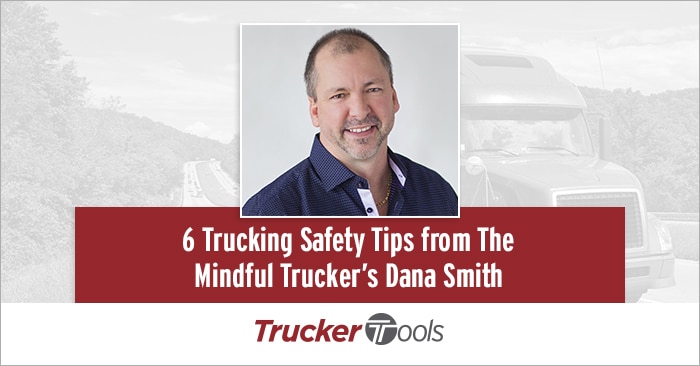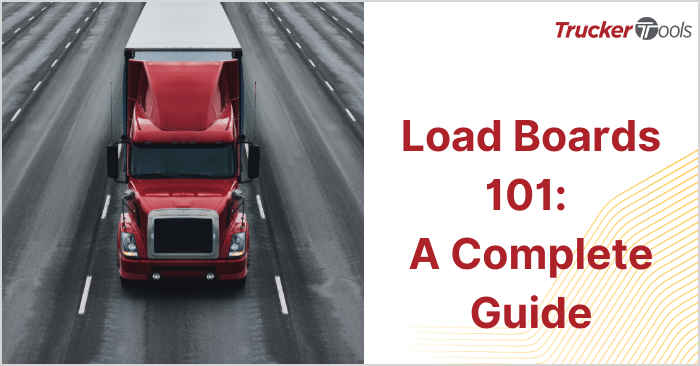Throughout the month of June in honor of National Safety Month, we’re raising awareness about on-the-job safety for those of you working in the transportation industry, especially for truck drivers. Trucker safety includes reducing driver distraction, combatting fatigue, trucker mental and physical health, technology-based safety systems and much more. We recently spoke with Dana Smith, founder and co-owner of The Mindful Trucker. Dana’s previous experience includes 30+ years of driving a commercial truck, from OTR long-haul to regional and local driving, and being trained as a relationship coach. Today with his partner Stephanie Allen, Dana offers safety, new driver, and health and wellness training through The Mindful Trucker.
Check out these six trucking safety tips that Dana shared with us.
Tip #1: Be Mentally Prepared
“Being mentally prepared to go on the road is key to your success,” Dana said. “Emotions play a huge part in your driving ability. Physical preparedness and skill are only part of it. There are a number of things that contribute to your mental preparedness when you’re on the road. Ask yourself, ‘Is my mind in the game?’ Do an emotional check-in with yourself. Are you angry, happy, sad, stressed out or worried about something? Getting behind the wheel with heightened emotions can cause you to be distracted from the task at hand.”
“Being mentally prepared to go on the road is key to your success,” Dana said. “Emotions play a huge part in your driving ability. Physical preparedness and skill are only part of it. There are a number of things that contribute to your mental preparedness when you’re on the road. Ask yourself, ‘Is my mind in the game?’ Do an emotional check-in with yourself. Are you angry, happy, sad, stressed out or worried about something? Getting behind the wheel with heightened emotions can cause you to be distracted from the task at hand.”
“Take a few moments before you start out on your journey to get your emotions in check by sitting still and relaxing quietly in your cab,” Dana advised. “Take deep breathes in and exhale slowly. This will help put your mind in a relaxed state before you venture out on the road and could be the difference between whether you arrive back home safely at the end of your trip.”
Tip #2: Don’t Be a Distracted Driver
“Distracted driving is the leading cause of accidents on our highways,” Dana shared. “Distracted driving isn’t only about talking on your cell phone. It could be texting, talking to passengers, eating or drinking, and/or using navigation or entertainment systems while driving. Animals in your vehicle or life events also can be very distracting. As a professional driver, it is your responsibility to drive with your attention on the road. You don’t want to be that person who hurts someone because you were distracted by something that you shouldn’t have been doing.”
“Put the phone down and focus 100 percent of your attention on what you’re doing,” said Dana. “Remember that no phone call or text is worth your life. If you have to, pull over to respond to phone calls and texts.”
Tip #3: Mirrors, Mirrors, Mirrors
“I can’t stress enough how important mirrors are when driving a commercial vehicle,” Dana said. “Mirrors are put on the vehicle to use — they are not just an ornament. They are your eyes on the road and on the sides of your vehicle. You have the big rectangle mirrors called West Coast mirrors and the small round convex mirrors that give you a bigger picture of the road. A common mistake that drivers make is not using their mirrors at all or moving left or right before checking their mirrors.”
“Look in your mirrors every three to five seconds,” Dana shared. “Use the left center right center pattern. Check your left mirror first, then the road in front of you, then the right mirror and then the road in front of you. Anytime you are going to turn, check your mirrors BEFORE you turn.”
“Look in your mirrors every three to five seconds,” Dana shared. “Use the left center right center pattern. Check your left mirror first, then the road in front of you, then the right mirror and then the road in front of you. Anytime you are going to turn, check your mirrors BEFORE you turn.”
Tip #4: Route Planning
“Route planning is an essential part of trucking,” said Dana. “Whether you use a trucking atlas or GPS device, planning your route can be the difference in whether you arrive at your destination or not. Do you know where you’re going? Do you know which highways you going to use or where are you going to fuel, eat and shower? These are things you need to know when organizing your trip. Where are you going to sleep? Are there detours along your route or are there any ‘No Truck’ routes that you need to avoid? Not knowing these things can cause a lot of unnecessary stress.”
“Don’t rely too much on GPS navigation systems,” Dana advised. “What happens if the GPS isn’t working properly or takes you on a route that isn’t a truck or hazmat route?
Learn how to read a trucking atlas in addition to using your GPS system. It might just save you from a serious problem or fine. Remember, it’s harder to get out of a jam with a tractor trailer than with a car.”
Tip #5: Be Mindful of Others on the Road
“Be mindful of all road users,” Dana said. “Who are the other road users? Other vehicles, bicycles, pedestrians, motorcycles, animals and even trains. It may sound funny when I say trains, but trains do cross roadways. All road users each have their own challenges with safety. Pedestrians, bicycles and motorcycles are hard to see. They don’t always yield to you. Animals are particularly hard to see at night and are often unpredictable.”
“Always pay attention to what you are doing and don’t assume you won’t be the one who doesn’t see something,” advised Dana. “It only takes two seconds to have something catastrophic happen. Stay alert at all times and focus on what you are doing. Look ahead as far as you can and scan your eyes back and forth on the road.”
“Always pay attention to what you are doing and don’t assume you won’t be the one who doesn’t see something,” advised Dana. “It only takes two seconds to have something catastrophic happen. Stay alert at all times and focus on what you are doing. Look ahead as far as you can and scan your eyes back and forth on the road.”
Tip #6: Three Point Contact Rule
“Use the three point contact rule when you are getting out of or climbing into your vehicle,” Dana shared. “This means holding on with two hands and a foot or two feet and a hand to stabilize yourself so you won’t slip and fall. One wrong move can result in serious consequences that can impact the rest of your life. Imagine, for example, if you are working on a flatbed trailer tarping a load and you slip and fall off the trailer. You could break your back or leg or worse. What if you can’t work for six months or are paralyzed for life? How will you provide for your family? That’s how fast it can happen.”
“A common mistake is being complacent and thinking injuries won’t happen to you,” Dana said. “Injuries from jumping down off the truck and/or trailer or being in too much of a hurry happen all the time. Instead, take a few seconds to use the three point contact rule to safely enter and exit your vehicle. Use a ladder to get on and off your trailer. I know it takes more time, but it is so worth it. The repercussions of an accident will have far reaching effects for you down the road.”
For more of our conversation with Dana, read “5 Mental Health and Wellness Tips from The Mindful Trucker.”






